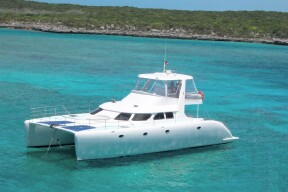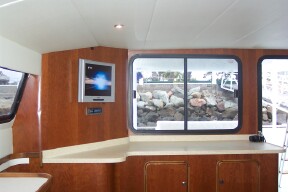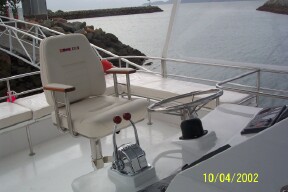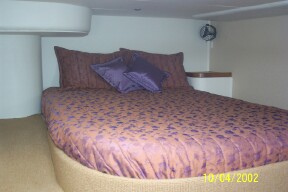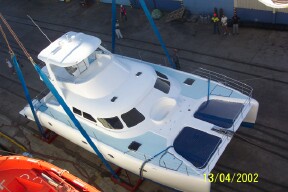
1480 (48′) NO WORRIES
REVIEW OF POWERPLAY 1480 “No Worries” (Dated 2002)
Story and pictures by Bruce HodgensIn 2002, Powerplay Catamarans were a Townsville company owned by James Dewing. Their second power catamaran, a PowerPlay™ 1480, was recently launched. Prior to being exported to the Caribbean for a charter company, I was invited for a cruise around Magnetic Island.
First some background information. The first boat produced by Powerplay Catamarans was a 12.5 metre boat aimed at the backpacker charter market. This boat is presently owned and chartered by Island Dive Adventures in The WhitSundays to do 2 and 3 day cruises and is constantly booked out in advance. It carries 12 –14 people comfortably. The design team at PowerPlay Catamarans then went on to design a Powerplay™ 1480 and a Powerplay™ 1650. Clients for these new designs were soon found and production began. Moulding for common components was undertaken to reduce costs and cut down on production time.
The vessels were been built using Duflex® planks (end grain balsa with unidirectional cloth) and knitted fabrics with epoxy resins. Furniture is constructed using Duflex® Honeycomb sheets to minimize weight and thus increase payload capacity. Customization of the designs is possible, especially the internal layout.
The owner of this new Powerplay™ 1480 is planning to put it in the luxury charter market in Dominica so the level of finish on this boat is very up-market. As I entered the saloon the initial impression is how huge this boat is inside. The saloon incorporates a large galley and settee with a table,
The things that really caught my eye were the cream leather upholstery, the dark Cherry wood timber veneer finish, and the Aztec (synthetic granite) bench tops. The effect was stunning. On the left as you entered was a large top of the range domestic double door fridge/freezer with icemaker. Obviously this boat wasn’t going to run short of cold beers. I guess there would also be plenty of room for food. Further forward on the port side is the large galley. This has a double stainless steel sink with plenty of cupboard space under, 2 burner electric stove, and a microwave oven.
On the starboard side is an “L” shaped settee that comfortably seats 6, and extra seats can be used on the other side of the table. An entertainment centre is also found on this side with a flat screen 20 inch TV, DVD/CD player and heaps of room for more toys to be added later. The saloon layout has been controlled to some extent by the need to have 4 entrances to the 4 double berths with en-suites in the hulls. Some of the other layout options have made better use of space in the saloon by only having 2 entrances to the hulls, but with only a single head/shower in each hull.
Visibility through the laminated glass windows is good, and the large rear window and wide door opening out to the cockpit makes it feel very open and airy. Air conditioning is available to cool the saloon if temperatures get a bit high, but there are overhead opening hatches. The forward berths are very salubrious. The queen size beds run across the boat, and have carpeted steps up each side. It makes it very easy for either person to get in or out of the bed. The en-suite facilities are through a forward bulkhead door and are very roomy and practical. The finish is all white 2-pack paint. There are plenty of storage cupboards. The rear berths have 2 singles that can be converted to a king size double. The berths are running fore/aft so the bed is entered at the foot (or head) of the bed if it is in double bed configuration. The ensuite for the rear berth is even bigger and once again finished in 2-pack paint for easy cleaning.
All berths have a lot of headroom, and you can easily sit up in bed to read. Lighting is readily available and fans are included. Each berth has its own air-conditioner, with individual controls making it easy to get a temperature to suit its occupants. There is also plenty of private room to move around to get dressed. The cockpit is very large and practical. There are seats on the starboard side and across the back and front of the cockpit, with storage space under. The cockpit has a roof that provides shade and protection from the elements. This roof runs all the way back to rear of the cockpit and has a post on either side to support it.
The posts are also handy to hold onto for balance. The stairs to the flybridge are on the port side and are stainless steel with teak treads. A table could be easily incorporated into the seating (as per the original layout) but this boat didn’t include one. Of course a plastic table may be a better option so it could be moved around. Behind the rear seats at the back of the cockpit is an extra deck area running across the boat. It has a stainless steel rail on the top to stop people falling over board, and if they are fishing from there with a hand line, it stops all those little nylon burns in the paintwork. What a great idea. The bulkhead has a wide top so you can sit down while fishing.
There is a very well designed boarding platform at the rear of both hulls. It gives easy access from the dock, especially if the boat is reversed in. Dinghies can pull up on the inside of the hulls and there is easy access to the boarding platform while the boat is kept into the wind and waves. Even more important is the excellent thick rubbing rail on the overhanging platform to keep the boat from being damaged by the dinghies. The platform has radial stairs allowing access to the cockpit level, and excellent stainless steel handrails. At the top of the stairs there is an engine room hatch that gives very easy access to the 230 horsepower Yanmars.
The engine rooms also give access to the steering rams and rudderpost. A stainless steel gate can be closed at sea to reduce the risk of people wandering out the back. Steps are provided forward of the engine room hatches to access the side decks. Stanchion and safety lines are high to make you feel secure. I particularly liked the toe rail on the outside edge of the deck.
On boats with a curved edge on their decks it is easy to slip and have to rely on the safety lines to stop you falling further. The deck is set down 50 millimetres forming the toe rail. The stanchion bases are all composite, as are the docking cleats. This greatly reduces the risk of leaks through the deck fittings, especially as they get older and loose. The side decks are quite wide and easy to negotiate even in rough seas. Stainless steel stanchions and rails continue all the way across the front of the boat and combined with the trampolines, give a large, safe area out the front. The trampolines are laced rope and are nice and tight.
A disadvantage is they do let more spray through carried by the wind as it pressurizes between the hulls. Of course water will drain away immediately if you take a green wave over the front. However, the feature that I really liked was a Jacuzzi in the foredeck. This is quite deep and has a seat around the side at about half the depth. What a great place for a party. There are plenty of lockers across the front of the bridgedeck area for ropes and chain. The anchor winch is set in a locker to keep the deck uncluttered and safe. On the hulls forward of the bridgedeck there are 2 enormous lockers. Both have floors at about 300 millimetres above the waterline. In the starboard locker was a 13.5 Kva genset – plenty to run all the air conditioners, microwave, TV, stove, hot water etc. On the port side was a water maker (36 litres/hour), and plenty of room for fenders.
The lockers themselves have very good seals and would be ideal for storing all the toys that may be needed on a boat like this, including dive gear. The flybridge has full headroom and has been fitted with clears.
A U shaped seating area wraps around the front of the flybridge and will be a popular place to sit. The helm is on a central console that has a very comfortable seat with armrests. On this boat, there is only one steering station and that is on the flybridge. It is an option to have a lower steering station, but this client didn’t think it was necessary.
Of course a remote autopilot control in the saloon is an option. There are the usual array of top quality chart plotter, radar screen, fish finder and autopilot as well as the standard Yanmar engine controls and instruments. Plenty of lighting for the flybridge and spotlights forward for docking or anchoring at night has been fitted. Aerials, radar dome and solar panels (if fitted) are on the bimini hard top well out of the way. The stainless steel safety rails around the edge of the flybridge have seats incorporated into them. Being a catamaran, and thus very stable, no restrictions are necessary on the number of people on the flybridge. In the tropics this is the best place to be on a hot day when underway. On the day of our test cruise we had 12 people on board including an assorted range of young children.
The weather was co-operating perfectly. Forecast was for light morning breezes with a strengthening sea breeze for the trip home in the afternoon. Magnetic Island is one of Townsville’s (and Australia’s) best-kept secrets. The island is only 4 nautical miles off-shore and has numerous lovely sandy beaches with fringing reefs. A lot of these beaches can only be easily accessed by boat, and we planned on swimming and snorkeling at one of them.
I got nominated as skipper for the day so the other adults could have a glass or two of wine during the day. After our pre-departure checks and briefing (especially for the children), I started the motors. Luckily they had tachometers because from up in the flybridge it was hard to hear them running. With twin motors fantastic visibility it was a breeze to manoeuvre this large cat away from the fuel wharf. From a standing position on the flybridge you could see every corner of the boat. James assured me this was no accident.
Considerable work had been done redesigning the flybridge on this model to enable the excellent visibility. Once under way it was a short distance to the open water before we could exceed 6 knots giving the motors time to warm up. In fact the motors were set at idle to do this speed. Steering has been greatly improved on this boat compared with the 1250 I tested previously. It is more responsive and direct, yet still light. Once in the open water we increased revs to 2800 and were cruising comfortably at 18 knots.
The boats attitude barely changes under power and it just slices smoothly through the water. Looking out behind there is a very small wake, especially compared with a planning hull on an equivalent size flybridge cruiser. I guess this is why these power cats are gaining in popularity – they are very efficient through the water and thus use less fuel and require less horsepower. While it was nice and calm I did some hard turns at full lock. It obviously slows the boat down but not as much as I was expecting. We were turning in about 5 boat lengths. The cat stays flat throughout the turn and feels like it is on rails. With one motor dropped back to idle it was still possible to turn the boat in both directions ensuring the ability to manoeuvre on one motor in the event of engine problems.
By this time I was being abused for disrupting everyone’s leisurely Sunday cruise so we continued to Radical Bay. I did have a play with the radar, chart plotter and autopilot on the way and all worked well and were easy to operate. On arrival at Radical Bay we dropped anchor close to the beach. The anchor winch is operated from the flybridge. The excellent visibility over the foredeck makes dropping and raising the anchor very easy and safe. No sooner had the anchor dropped and 6 children were over the side and playing in the water. All the adults were in the flybridge and it proved to be an ideal lookout point to watch them. This cat has a huge deck area so 12 people on board made it feel like a ghost town. I’m sure 20 people on board would be easily catered for, with even more possible if needed. By the time we came home later in the afternoon the sea breeze had kicked in to 15 to 20 knots and the sea was choppy.
The trip home along the rocky cliffs would be a good test for the cat because the reflected waves would create a very confused sea state. I had done this same trip dozens of times in other boats and it can be very uncomfortable, especially for people that aren’t used to the rough water. We increased revs to cruise speed and headed straight into the chop initially. This created quite a bit of spray over the front hulls and through the trampolines. Other than the occasional spray from larger waves, the catamaran handled the chop with ease at all speeds. At higher speeds the ride smoothed out as the hulls cut through the waves rather than going up and down the wave faces.
There was no slapping of waves under the bridgedeck thanks to the high bridgedeck clearance of 850 millimetres. As we turned the corner of the island at Orchid Rocks we met the waves side on. Instead of a slow roll there was a fairly small but sharp change as the waves went under the hulls. Even on the fly bridge the movement wasn’t particularly uncomfortable. Occasionally a larger wave would break on the inside of the leeward hull, but this was hardly felt. I’m sure the noise in the hull would have been significant, but it certainly wouldn’t create any problems for a boat built to strict survey standards. Cruising at 20 knots took very little time to cover the 10 miles to the marina.
Fuel consumption was difficult to estimate from such a short trip but when the boat was delivered from Miami (USA) to the Caribbean the owner reported 20 litres per hour per motor at 20 knots. and quiet, The boat has a total fuel capacity of 2,400 litres evenly distributed in both hulls. This enabled the owner to do the 1100-mile trip without refueling. This is fantastic! Most of the flybridge cruisers I have been on would have triple this fuel consumption at these speeds. Water tanks only hold 500 litres but with a large water maker this is plenty. Back in the marina we had a new position on the fuel wharf in between 2 other boats. Nothing like a challenge! The stronger wind was initially a concern but once we had ropes organized we approached the dock with the rudders centered and then just used the motors to manoeuvre the nose in until we had a bow line on.
With the centerline of the hulls 5.2 metres apart the boat turns effortlessly, even at idle revs. We soon had the stern alongside and tied down. No real drama – don’t know what I was so concerned about. Overall this boat is a credit to PowerPlay Catamarans. It looks great, is economical to run and the spacious interior is excellent for private or charter operations.
PowerPlay Catamarans have developed a real winner. They are now building a range of boats between 12.5 metres and 17 metres based on developments of the first 2 boats. The next boat is a 1650 sports fishing boat, also for the Caribbean, and is due for launch in September. Further details can be found on their website at www.powerplaycatamarans.com.au. Or [email protected]. Incredible interest has been generated by this 1480 for charter operations, both in Australia and overseas.





